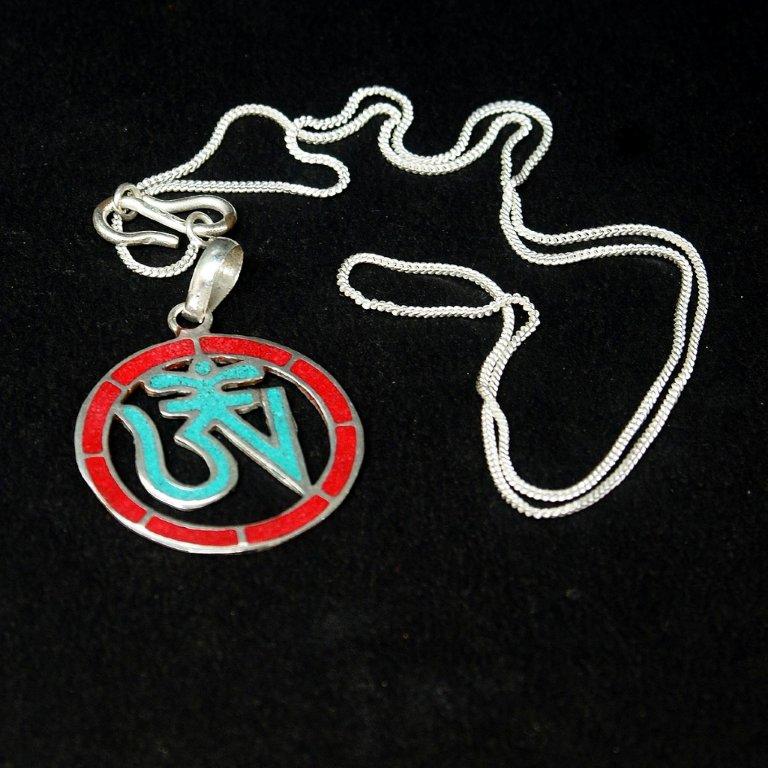About Turquoise :
Turquoise is perhaps the oldest stone in man's history, the talisman of kings, shamans, and warriors. It is a stone of protection, strong and opaque, yet soothing to the touch, healing to the eye, as if carved from an azure heaven and slipped to earth. Its unique shade of blue, often blue-green, lends it name, Turquoise, to all things of this tranquil hue. The delicate veining or mottled webbing in cream or brown is inherent to the stone and serves to enhance its character.
About Coral:
Precious coral or red coral is the common name given to Corallium rubrum and several related species of marine coral. The distinguishing characteristic of precious corals is their durable and intensely colored red or pink skeleton, which is used for making jewelry. This Stone has various Benifits like:
Coral is good to stimulate tissue regeneration.
Coral soothes tension.
It is believed (in ancient times) that coral is good for protection against skin diseases - when worn as a necklace.
Coral helps with lethargy.
Coral helps with nutrient deficiency.
Coral has healing power energies.
Dark red coral - used for stimulating and heating the bloodstream.
Pink coral is used to restore harmony to your heart.
Coral is a good depression aid.
Coral helps with digestion.
Coral helps the body to clear cholesterol from the circulatory system by enhancing the production and absorption of niacin into the physical body.
Coral helps with lung difficulties.
Metal Pendant
A Nepali metal pendant is a traditional piece of jewelry that is crafted in Nepal using traditional techniques and materials. The pendant is typically made of metal, such as brass or silver, and is intricately designed and embellished with cultural motifs and symbols.
The design of the pendant may be inspired by Nepali culture and symbolism, with patterns and motifs that represent different aspects of Nepali life, such as nature, religion, or social customs. These designs may be created using traditional techniques, such as etching, stamping, or engraving, and may be further embellished with beads, gems, or other decorative elements.
Read More
The pendant may be worn on a chain or cord around the neck, and is often used as a statement piece or as a talisman to protect the wearer from negative energies or evil spirits. It is also commonly given as a gift to family members or friends, particularly on special occasions, such as weddings or religious ceremonies.
Overall, a Nepali metal pendant is a beautiful and unique piece of jewelry that represents the rich cultural heritage of Nepal and the skill and artistry of its craftsmen. It is a treasured possession that carries deep meaning and significance for those who wear it or receive it as a gift.
Turquoise : Brief Introduction
Turquoise is a purification stone. It dispels negative energy and can be worn to protect against outside influences or pollutants in the atmosphere. Turquoise balances and aligns all the chakras, stabilising mood swings and instilling inner calm. It is excellent for depression and exhaustion, it also has the power to prevent panic attacks. Turquoise promotes self-realisation and assists creative problem solving. It is a symbol of friendship, and stimulates romantic love.
Turquoise aids in the absorption of nutrients, enhances the immune system, stimulates the regeneration of tissue, and heals the whole body. It contains anti-inflammatory and detoxifying effects, and alleviates cramps and pain. Turquoise purifies lungs, soothes and clears sore throats, and heals the eyes, including cataracts. It neutralises over acidity, benefits rheumatism, gout, stomach problems, and viral infections
♥ Purification ♥ Serenity ♥ Protection ♥ Wisdom ♥ Balance ♥ Strength ♥ Friendship ♥ Love ♥ Positive thinking ♥ Sensitivity
Turquoise is a mineral that is a hydrous phosphate of copper and aluminium. Turquoise is an 11th Anniversary gemstone.
Chakras - Heart Chakra, Throat Chakra, Third Eye Chakra
Birthstone - December (Blue Turquoise)
Zodiac - Scorpio, Sagittarius, Aquarius, Pisces
Planet – Venus & Neptune
Element – Earth/Air/Fire
Vibration - Number 1
Typical colours - Turquoise, blue, green, yellow-green
Read More
Coral : Brief Introduction
Coral represents diplomacy and concurrence. It quiets the emotions and brings peace to within the self. Facilitates intuition, imagination and visualisation. Coral expedites and accelerates the transfer of knowledge. Coral strengthens the circulatory system and the bones of the body. It stimulates tissue regeneration and nourishes the blood cells. Treats disorders of the spinal canal, the alimentary canal, the nervous system, and the thalamus.
♥ Absorbs negative energy ♥ Platonic love ♥ Friendship ♥ Community ♥ Creativity ♥ Passion ♥ Romantic love ♥ Wisdom ♥ Optimism ♥ Enthusiasm ♥ Balance ♥ Relaxation ♥ Protection ♥ Safe travel on water
Coral is a 35th Anniversary gemstone.
Zodiac - Taurus, Pisces
Planet - Mars
Vibration - Master Number 22
Typical colours - Black, pink, red, white, blue
Chakras - Base Chakra
Zodiac - Libra
Vibration - Number 4
Read More
Om-Tibetan : About Tibetan Om
In Tibetan Buddhism, Om is often placed at the beginning of mantras and dharanis. Probably the most well known mantra is "Om mani padme hum", the six syllable mantra of the Bodhisattva of compassion, Avalokiteśvara. This mantra is particularly associated with the four-armed Shadakshari form of Avalokiteśvara. Moreover, as a seed syllable (bija mantra), Aum is considered sacred and holy in Esoteric Buddhism.
Some scholars interpret the first word of the mantra oṃ maṇipadme hūṃ to be auṃ, with a meaning similar to Hinduism - the totality of sound, existence and consciousness.
Oṃ has been described by the 14th Dalai Lama as "composed of three pure letters, A, U, and M. These symbolize the impure body, speech, and mind of everyday unenlightened life of a practitioner; they also symbolize the pure exalted body, speech and mind of an enlightened Buddha." According to Simpkins, Om is a part of many mantras in Tibetan Buddhism and is a symbolism for "wholeness, perfection and the infinite"
Read More
